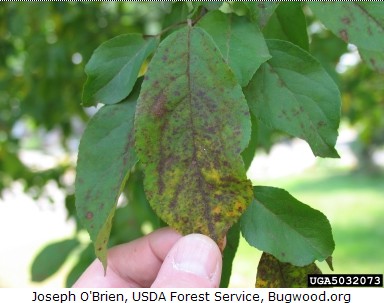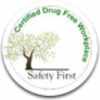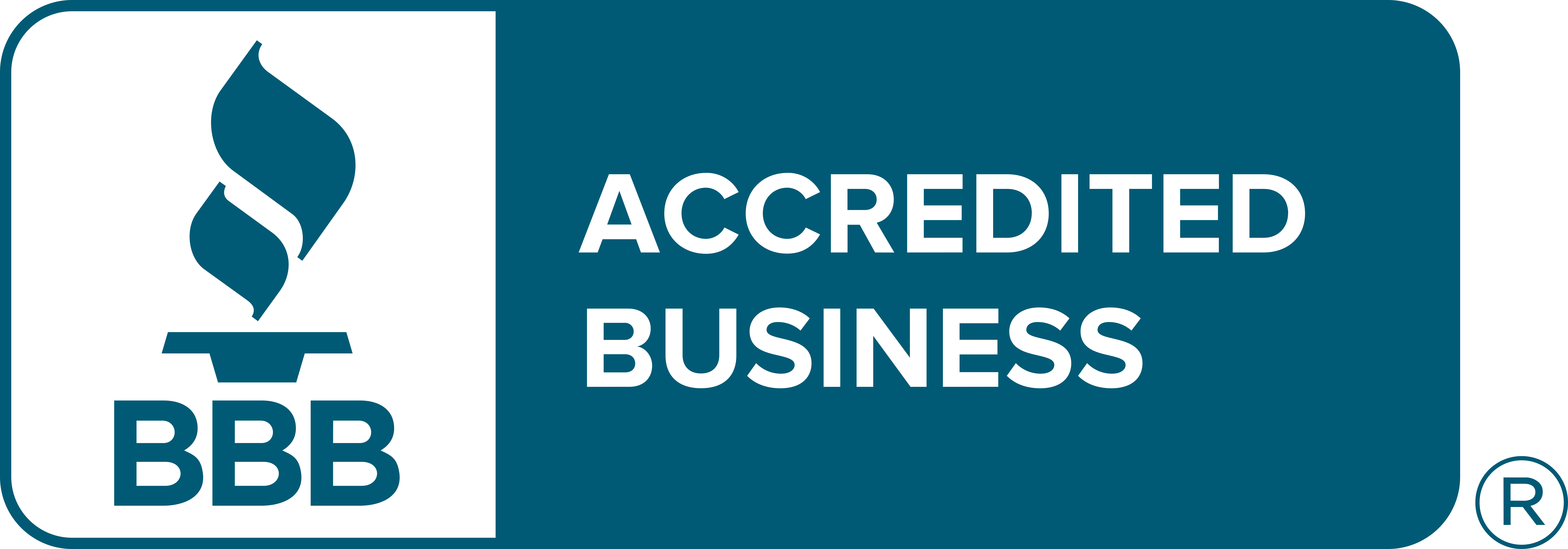 Description: Apple scab is a serious disease in virtually all apple-producing regions worldwide. If not controlled it can cause extensive losses where humid, cool weather occurs during the spring months. Losses can occur from fruit infection or repeated defoliation.
Symptoms: Scab infections are normally noticed on the leaves first. They become twisted and puckered and have black spots on their upper surface. On the underside of the leaf, the spots are velvety and may grow to cover the entire leaf surface. Severely affected leaves may turn yellow and drop. Scab can also infect flower stems and cause flowers to drop. Later in the season, scabby spots may be found on fruit. They begin as sooty, grey-black, and sometimes greasy looking lesions with a red halo. The lesions become sunken and tan and have spores around their margins. Infected fruit distorts and can crack. Severely affected young fruit can drop.
The disease usually overwinters in leaves and fruit on the orchard floor. Most infections happen at about the time of bud break, or shortly thereafter. In spring, air currents or splashing water carry primary spores from infected leaves to flowers, leaves or fruit where they germinate and cause infections. New spores are produced on the infected leaf or fruit surface 8 – 17 days later. Infection occurs most rapidly between 55 and 75 degrees and leaves must remain continuously wet for a minimum of 9 hours for infection to occur. If spring is dry, scab is not usually a problem.
Action: Scab can destroy an apple crop. In single backyard trees, rake leaves and remove them in winter.
Either destroy or thoroughly compost the leaves. For sprinkler-irrigated trees, avoid wetting the foliage with water. If you are using sprinklers that wet leaves, irrigate between sunrise and noon. Fungicides can also be used but timing is critical and follow ups will be necessary.
Thank you for reviewing this information. Schneider Tree Care is committed to preserving and enhancing the quality of your property through tree care education and services. We employ professionally trained and certified arborists who are available to meet with you for a consultation at no charge. If you have any questions or need additional information regarding the health of your trees, please contact us.
Description: Apple scab is a serious disease in virtually all apple-producing regions worldwide. If not controlled it can cause extensive losses where humid, cool weather occurs during the spring months. Losses can occur from fruit infection or repeated defoliation.
Symptoms: Scab infections are normally noticed on the leaves first. They become twisted and puckered and have black spots on their upper surface. On the underside of the leaf, the spots are velvety and may grow to cover the entire leaf surface. Severely affected leaves may turn yellow and drop. Scab can also infect flower stems and cause flowers to drop. Later in the season, scabby spots may be found on fruit. They begin as sooty, grey-black, and sometimes greasy looking lesions with a red halo. The lesions become sunken and tan and have spores around their margins. Infected fruit distorts and can crack. Severely affected young fruit can drop.
The disease usually overwinters in leaves and fruit on the orchard floor. Most infections happen at about the time of bud break, or shortly thereafter. In spring, air currents or splashing water carry primary spores from infected leaves to flowers, leaves or fruit where they germinate and cause infections. New spores are produced on the infected leaf or fruit surface 8 – 17 days later. Infection occurs most rapidly between 55 and 75 degrees and leaves must remain continuously wet for a minimum of 9 hours for infection to occur. If spring is dry, scab is not usually a problem.
Action: Scab can destroy an apple crop. In single backyard trees, rake leaves and remove them in winter.
Either destroy or thoroughly compost the leaves. For sprinkler-irrigated trees, avoid wetting the foliage with water. If you are using sprinklers that wet leaves, irrigate between sunrise and noon. Fungicides can also be used but timing is critical and follow ups will be necessary.
Thank you for reviewing this information. Schneider Tree Care is committed to preserving and enhancing the quality of your property through tree care education and services. We employ professionally trained and certified arborists who are available to meet with you for a consultation at no charge. If you have any questions or need additional information regarding the health of your trees, please contact us. 









